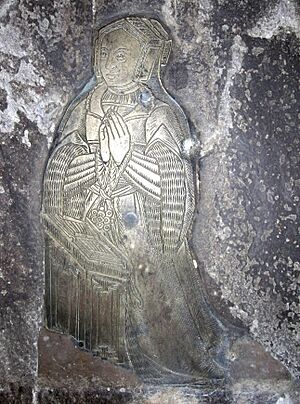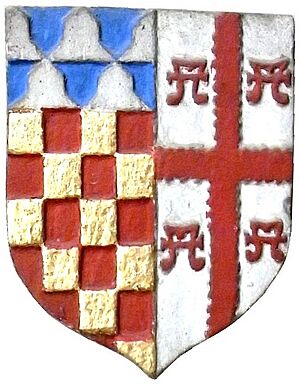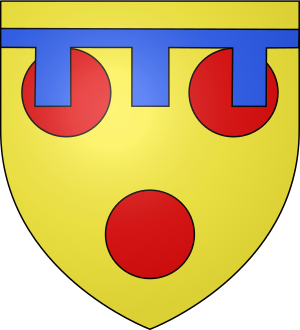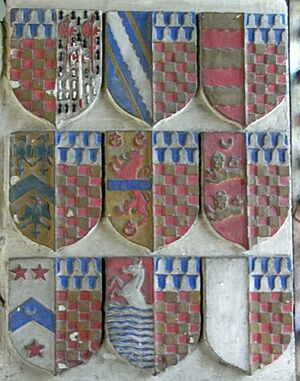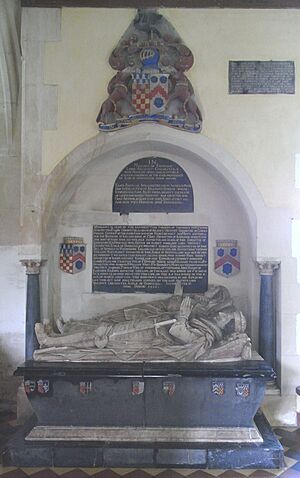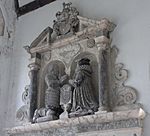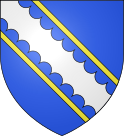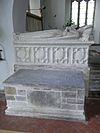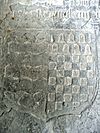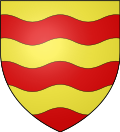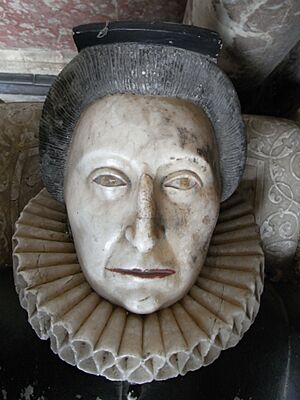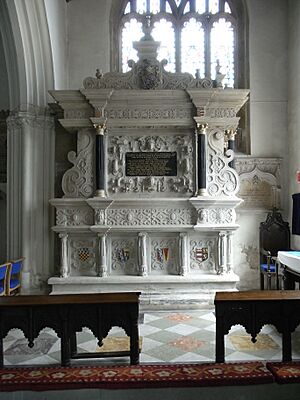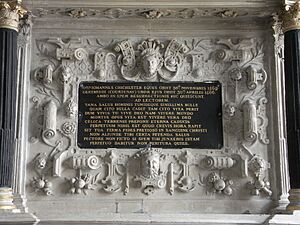John Chichester (died 1569) facts for kids
Sir John Chichester (1519/20-1569) was an important man from Devon, England. He lived at Raleigh, near Barnstaple. He was a naval captain and a strong supporter of the Protestant faith. He served as the Sheriff of Devon in 1550-1551. He was also elected as a Member of Parliament for Devon three times and for Barnstaple once. His family's estate at Raleigh gave him a lot of influence in the Barnstaple area.
Contents
Sir John's Family Background
The Chichester family had lived at Raleigh since the mid-1300s. Sir John was the son of Edward Chichester, who died in 1526. His mother was Lady Elizabeth Bourchier, who passed away in 1548. Her small brass memorial can still be seen in St Brannock's Church in Braunton.
Lady Elizabeth was the daughter of John Bourchier, the 1st Earl of Bath. His family home was Tawstock Court, not far from Raleigh. In the 1500s and 1600s, Raleigh and Tawstock Court were likely the biggest houses in North Devon. Sir John Chichester inherited his family's estates from his grandfather in 1536.
Sir John's Public Life
As a young man, Sir John Chichester joined the Royal Navy. In 1544, he was with King Henry VIII in France during the Siege of Boulogne. This was a major battle where the English tried to capture the French town. In 1545, he was the captain of a ship called the Struce of Dansick.
In 1549, a big uprising called the Western Rebellion happened in England. Sir John was in London when it started. He quickly returned to Devon to help the royal forces. He fought under the command of John Russell, who was a powerful lord. Russell likely suggested Sir John to the king for the role of Sheriff of Devon in 1550-1551. As a thank you, Russell gave Sir John and another knight, Sir Arthur Champernon, the metal clappers from church bells. These had been removed by royal order to stop rebels from using them to call people to arms.
After King Henry VIII died in 1547, his young son Edward VI became king. Sir John became a strong supporter of the Duke of Somerset. Somerset was King Edward's uncle and acted as the country's leader, known as the Lord Protector. When Somerset lost power in 1551, Sir John was briefly sent to the Tower of London with him.
When King Edward VI died in 1553, Sir John Chichester refused to support the Duke of Northumberland. Northumberland wanted his daughter-in-law, Lady Jane Grey, to become queen. Instead, Sir John joined his cousin, John Bourchier, the 2nd Earl of Bath. They were among the first to declare Queen Mary as the new monarch. Queen Mary rewarded Sir John by making him a knight. He received this honor just three days before her first Parliament began in 1553.
In 1555, Sir John traveled with Francis Russell, the 2nd Earl of Bedford, on a special trip to Brussels. He then continued on to Venice. In 1556, he was arrested again and sent to the Tower of London. This was because he was thought to be involved in a plot against Queen Mary. He was soon released but remained under certain restrictions.
After Queen Mary died and Queen Elizabeth I came to the throne in 1558, Sir John Chichester returned to public life. He was active in local and national politics until his death in 1569. In 1566, he gave up his rights and interests in the Manor of Barnstaple to the town's Mayor and leaders.
Sir John's Family Life
Sir John Chichester married Gertrude Courtenay. She was the daughter of Sir William III Courtenay of Powderham, another very important family in Devon. Sir William was a Member of Parliament and served as Sheriff of Devon three times. He was also a close attendant to King Henry VIII.
Sir John and Gertrude had seven sons and nine daughters. Their children married into many of the leading families in Devon. Two of his daughters even married children who were first cousins of Lady Jane Grey. The marriages of his children are shown with family symbols on his monument in Pilton Church.
Family Symbols Panel
High up on the right side of Sir John Chichester's monument in Pilton Church, there is a panel with family symbols. These symbols show his children and the families they married into. The first symbol on the top left shows Sir John's family symbol combined with the Denys family symbol. This represents the marriage of his oldest son and heir. The other symbols show the family symbols of his daughters' husbands combined with Sir John's family symbol.
Here are some of the families his children married into:
- Denys
- Fortescue
- Basset
- Bluett
- Dillon
- Hatch of Aller
- Pollard
- Trevelyan of Nettlecombe
His Sons
Sir John had seven sons:
- Sir John Chichester (died 1586): His oldest son and heir. He married Ann Dennis.
- Arthur Chichester, 1st Baron Chichester of Belfast (1563-1624/5): His second son. He became Governor of Carrickfergus in Ireland.
- Edward Chichester, 1st Viscount Chichester (1568–1648): His third son. His statue can be seen in Eggesford Church.
- Charles Chichester: His fourth son, who did not have children.
- Sir John Chichester, junior: His fifth son. He was also Governor of Carrickfergus and died without children.
- Sir Thomas Chichester: His sixth son.
- Adrian Chichester: His seventh son, who did not have children.
His Daughters
Sir John had nine daughters:
- Elizabeth Chichester (died 1630): She married Hugh Fortescue, who was Sheriff of Devon. Their statues can be seen in Weare Giffard Church.
- Cecilia Chichester: She married Thomas Hatch.
- Eleanor Chichester (died 1585): She married Sir Arthur Bassett, who was also a Member of Parliament. Their tomb with family symbols is in Atherington Church.
- Mary Chichester (died 1613): She married Richard Bluett. Their statues are on their monument in Holcombe Rogus Church.
- Grace Chichester: She married Robert Dillon.
- Dorothy Chichester: She married Sir Hugh Pollard.
- Urith Chichester: She married John Trevelyan.
- Bridget Chichester: She married Sir Edmund Prideaux.
- Susannah Chichester: In 1584, she married John Fortescue. Their son, Sir Faithful Fortescue, had a successful military career in Ireland. He started a new branch of the Fortescue family there.
Death and Burial
Sir John Chichester passed away on November 30, 1569. He was buried in Pilton Church, which was close to his home at Raleigh in Devon.
His Monument in Pilton Church
There is a very fancy monument for Sir John Chichester in the Raleigh Chapel of Pilton Church. It is decorated with intricate designs but does not have a statue of him. In the middle of the monument, there is a stone tablet with Latin writing.
The writing says that Sir John Chichester died on November 30, 1569, and his wife, Gertrude Courtenay, died on April 30, 1566. It says they both rest there, hoping for resurrection.
The inscription also shares a message for anyone who reads it: "The health of a person is like an empty, puffed-up bubble. As quickly as a bubble bursts, so quickly does life end. While you are alive, live for God! For to live for the world means life is like death. To live for God is true life. Choose heavenly things over earthly things, and eternal things over things that fade away. Nothing lasts forever; what you gain, time takes away. Let your faith be strong in the precious blood of Christ. You should not look for true salvation anywhere else. If you truly hold onto this hope, you will be given endless peace that will never disappear."


